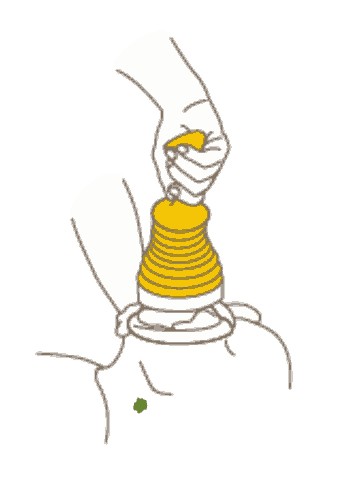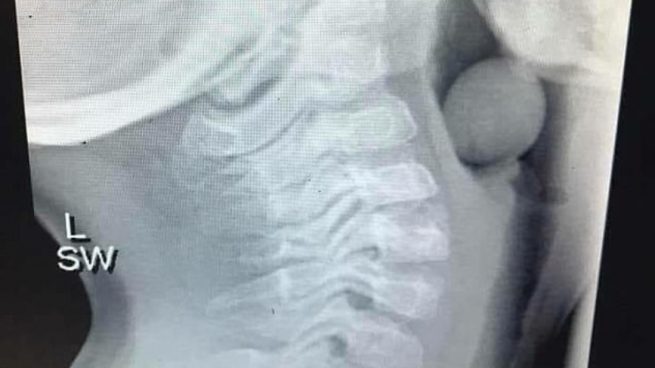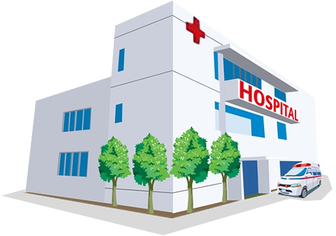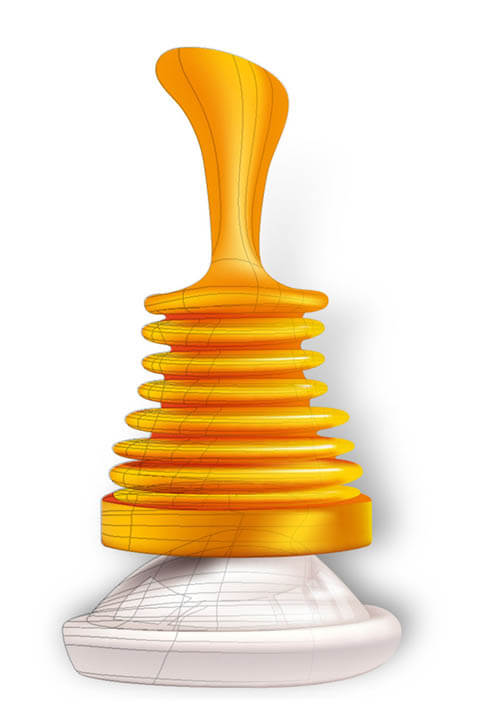Download and print out the ACCC's Choke Test Tool. It helps parents to correctly size food and other items that children may choke on.
Hints to prevent choking when feeding adults... sit the person in an upright position, if bedridden, raise the head up to achieve this.
- Adjust the size of the snacks and the feeding speed to the tolerance of the person.
- Avoid pushing or forcing food.
- Alternate between solids and liquids.
- Vary the placement of food in the person's mouth. For example, if the person has muscle weakness in the right part of the mouth, feed it from the left.
- Determine the density that the individual tolerates best.
|
Choking is the blockage by a foreign body of the airway. This occurs when a piece of food or a small object gets stuck in the throat which may not allow air to enter and exit the lungs normally. Normally, when a choking occurs, our body reacts by instinctively coughing. Usually coughing will enable most people to relieve their own obstruction. This however may not be true in children, the elderly and those with swallowing difficulties.
If coughing does not immediately clear the obstruction, the person only has a few minutes (in the case of a complete obstruction) before brain damage and death is likely to occur. First Aid therefor have to applied immediately and if they fail the use of the LifeVac anti-choking device. |
A Partial Obstruction occurs when the foreign body in the airway does not completely block the airway and so some air can still move in and out of the persons lungs. One of the best ways to tell if the person has a partial obstruction is if they have an effective cough. If they do the obstruction in partial. If the person has a partial obstruction and is still a pink colour and is not becoming less awake there first aid measures should be avoided and the person should be seen in a hospital Emergency Department immediately. Trying to relieve this sort of obstruction may force it further down or more tightly impact the material in the airway ans thus create the more dangerous Complete Obstruction.
Inform the victim that you are going to help them.
- Stand or kneel behind the victim.
- Wrap your arms around the person (below their arms). Form one fist with one hand closed and the other covering it and place the fist on the upper abdomen of the victim; Between the navel and the end of the sternum (where the lowest ribs intersect).
- Pull sharply and forcefully. The force should be directed inwards and upwards (like you are trying to pull towards the middle of the person's upper back).
- Stop after each compression and check to see if the object has been ejected.
- If the obstruction has not been released, repeat the manoeuvre up to 5 times.
Alternatively, when trying to relieve an obstruction on a pregnant women or an obese person with a large abdomen, Chest Thrusts are the preferred technique:
- Stand or kneel behind the victim.
- Wrap your arm around the person (under the arms)
- Form one fist with one hand closed and the other covering it and place the fist on the middle of the chest (where we do CPR compressions).
- Stop after each compression and check to see if the object has been ejected.
- If the obstruction has not been released, repeat the manoeuvre up to 5 times.
Repeat these steps and call Ambulance via 000
If the victim loses consciousness, place them on the floor and commence CPR
- Stand next to and slightly behind the victim.
- Place the person in a head down position. For children this could be over your knee or for larger children or adults, bending them over a chair or supporting their chest with one hand while bending them forward.
- Give up to five (5) sharp blows to the back (between the shoulder blades) using the ball of your hand.
- If back blows fail move on to chest or abdominal thrusts. On children less that one (1) year old chest thrust are preferred to reduce the risk of injury and these can be done with the infant flat on their back and applying compressions in the centre of the chest (a bit like CPR compressions). Abdominal Thrust (also called Heimlich Manoeuvre) :
- Stand or kneel behind the victim.
- Wrap your arms around the person (below their arms). Form one fist with one hand closed and the other covering it and place the fist on the upper abdomen of the victim; Between the navel and the end of the sternum (where the lowest ribs intersect).
- Pull sharply and forcefully. The force should be directed inwards and upwards (like you are trying to pull towards the middle of the person's upper back).
- Stop after each compression and check to see if the object has been ejected.
- If the obstruction has not been released, repeat the manoeuvre up to 5 times.
Alternatively, when trying to relieve an obstruction on a pregnant women or an obese person with a large abdomen, Chest Thrusts are the preferred technique:
- Stand or kneel behind the victim.
- Wrap your arm around the person (under the arms)
- Form one fist with one hand closed and the other covering it and place the fist on the middle of the chest (where we do CPR compressions).
- Stop after each compression and check to see if the object has been ejected.
- If the obstruction has not been released, repeat the manoeuvre up to 5 times.
Repeat these steps and call Ambulance via 000
If the victim loses consciousness, place them on the floor and commence CPR
|
As a result of a Complete Obstruction and first aid measures, victims can suffer injuries. Sometimes, the process of choking can result in a fluid buildup in the lungs of the victim, that may need to be treated with medications. Additionally, first aid measures are necessarily violent and desperate. This rarely results in any injuries, however the victim may need to be observed in hospital after suffering a Complete Obstruction.
|
|
LifeVac is an anti-choking device specially designed to release airway obstruction from the victim by generating a negative pressure. The pressure generated is 3 times higher than that generated through abdominal thrusts (Heimlich Manoeuvre).
 |









